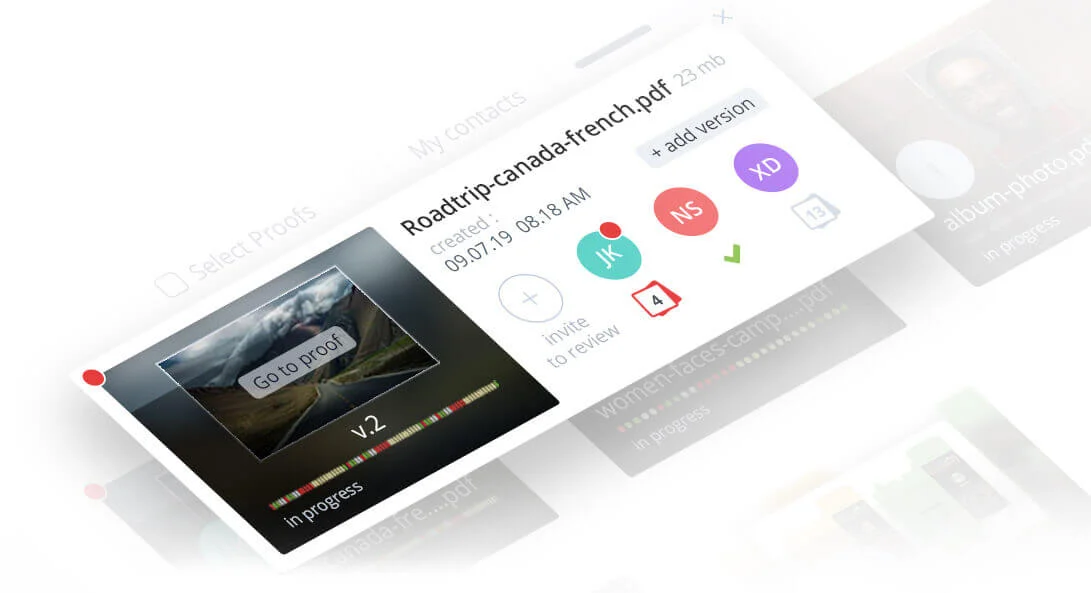In creative businesses or any businesses with creative workflows, streamlining the approval process to make sure it’s as efficient as possible is crucial for the organization’s productivity and efficiency.
This is where an optimized proofing system is necessary.
Thanks to cloud technology and high-speed internet, now we have online proofing as the more efficient alternative to the standard approval process that is often frustrating for many creative teams.
By optimizing your proofing process to be as efficient as possible, creative businesses can significantly improve the speed and efficiency of the approval process. In turn, this will produce numerous benefits that we will discuss in this article.
Online Proofing: The Key To Optimizing Approval Processes
First, what is the “proofing” process?
The term proofing originated from the printing industry and has been around for centuries since the age of the Gutenberg printing machine.
Back then, a “proof” refers to a mock print that a printing company gives to its client for approval. For example, when a client wants to print 100 posters, the printing company only prints one proof. When the client approves the proof, the actual printing process will start, and vice versa.
So, we can say that the proofing process is the predecessor of today’s approval workflows in creative businesses. A proof prevents costly errors and acts as an approval agreement between the printing company and the client.
Then, computers were invented, and by the late 1990s, personal computers were already widely available. The proofing process also evolved, and now we can show a “soft proof” by showing clients our computer screens. Later on, there’s the internet, and now we can send image files over the internet, allowing the email-based proofing process to become the standard of the internet age.
However, email-based proofing has its flaws: different computer monitors are calibrated differently so that they may produce different dispaly colors. Also, email is not a very effective technology when it comes to facilitating the approval process.
For instance, it can be challenging to look for a specific version of the creative deliverable in an email thread with hundreds of emails in the thread. This is where online proofing comes in.
Instead of using a back-and-forth communication like the email-based proofing process, online proofing uses a dedicated online proofing system to facilitate centralized communication.
The creative worker and the approver can communicate and collaborate in real-time on the platform in cloud-based online proofing. All shared files are easily searchable whenever needed.
In an online proofing process, all team members and stakeholders can easily upload files, leave real-time feedback and comments, and approve and ask for a revision in a single platform.
With this, it’s easier for everyone involved in the approval process to collaborate, streamlining the approval process while also improving the transparency and accountability of the whole approval process. Not only are the content creators accountable in an optimized proofing system, but we can also track whether a reviewer has reviewed and provided feedback on the deliverable on time. When disputes and confusion occur, we can easily track different versions of the deliverable, track previous feedback, and resolve.
Benefits of an Optimized Proofing System
By having an optimized proofing system, we can eliminate many common issues in creative approval processes, which in turn can provide us with the following benefits:
Improved efficiency of the approval process
Traditional proofing and email-based proofing processes often cause various bottlenecks in the approval workflow. On the other hand, a delay in the approval workflow alone can cause unwanted chain reactions leading to missed deadlines, creative projects delivered below standards, and other issues.
With an optimized proofing system, we can eliminate various inefficiency issues and streamline the entire approval process.
1. Reducing approval process costs
Lengthy and inefficient approval processes can be costly in the long run. While you may need to invest in a new online proofing system at first, and optimized proofing process will significantly lower the overall costs associated with the approval process.
For example, we can eliminate the cost of printing and distributing printed documents, which is common in a traditional paper-based approval process. Also, by ensuring an efficient approval process, we can ensure the project meets the deadline and stays on budget.
2. More control and transparency
With the online proofing system acting as a centralized hub for the whole proofing process, it’s easier to track whether a content creator has sent a deliverable and whether a designated reviewer has received it. We can keep track of whether a reviewer has left feedback, asked for a revision, and other essential changes in the approval process.
With an optimized proofing process in place, we’ll have fewer revision cycles and avoid administrative issues like sending the same file over and over again.
3. More efficient collaboration
Today, remote working has become more common for creative workers, a phenomenon accelerated by the global COVID-19 pandemic.
In this situation, traditional proofing workflows are no longer effective and efficient. Not to mention, digital files have grown larger and larger in size. Sending large files via email is no longer convenient.
An optimized proofing system can eliminate this issue by offering a centralized place where everyone can communicate and collaborate in real-time.
Conclusion
An optimized proofing system can significantly streamline and improve the efficiency of the approval workflows in creative businesses.
By facilitating a more transparent and efficient feedback process in a centralized hub, all parties involved in the proofing process can contribute more effectively in various stages of the approval process. This is especially important when many people and/or many steps are involved in the approval workflow.
An effective approval process will make it easier for the organization to manage a higher volume of creative production while also reducing the product deliverables’ compliance risks.
As a result, investing in an online proofing system can save time and resources and allow the business to generate more revenue.



































